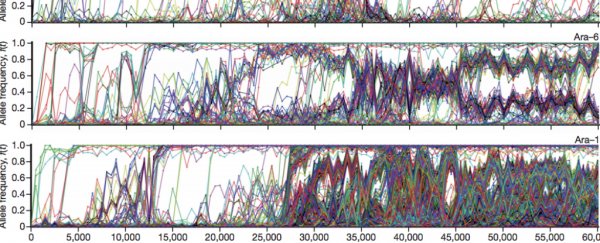Scientists have spent the past 30 years carefully tracking evolution across more than 68,000 generations of E. coli bacteria - the equivalent of more than 1 million years of human evolution.
The latest results suggest we might have been wrong about one of the fundamental aspects of how species evolve.
Traditionally, researchers predicted that the evolution of a species would slow down and potentially stop after they reached a peak level of 'fitness' in their chosen environment. And across the short timeframes we're able to study, it's often hard to tell whether this is true or not.
But the E. coli experiment shows that while evolution might slow down, peak fitness might not actually exist at all. In other words, evolution just keeps going.
"In our study we found that even though the E. coli populations in our experiment have been evolving in a very simple environment for a long time, they are still adapting to their environment," says one of the research team, Mike McDonald, from Monash University in Australia.
"In other words the fit get fitter. But the established theory tells us that adaptation should have stopped by now since there should be a 'fitness peak' that the E.coli should have reached … our work shows that this is not the case."
One potential explanation McDonald puts forward is that, as the E. coli evolve, they also change their environment, which in turn drives further adaptation. Recent studies indicate, for humans at least, that might be the case.
There's still a lot to learn. But this latest study is important because, despite the abundance of evidence we have to support the theory of evolution, we still don't have much insight into how evolution affects a species over a long time period, for the simple reason we can't go back in time and collect the necessary data.
But almost 30 years ago, in February 1988, Michigan State University researcher Richard Lenski set out to change that.
He took 12 flasks, added E. coli, a seeder solution, and a glucose-based food source, and left them overnight at 37 degrees Celsius (98.6 degrees Fahrenheit).
He only added enough food for the bacteria to survive until the next morning, adding pressure on the environment to encourage natural selection to occur - only the fit should survive.
The following afternoon he took a sample of the resulting bacteria solution, put it in a new flask with identical conditions, and repeated the experiment… for the next three decades. He essentially created an entire bacterial universe, or 12, for us to study.
Every 75 days, which is roughly the equivalent of 500 E. coli generations, some of the bacterial solution is put into a -80 degrees Celsius (-112 degrees Fahrenheit) freezer to act as a time capsule for the genes of the population at that time point.
The researchers have now gone back and mapped the genetic mutations that were introduced over that time.
The results have been nothing short of fascinating. Across all 12 cultures, Ars Technica reports that the bacteria cells are now bigger than they were back in 1988.
As you might expect, they also metabolise glucose more efficiently and grow faster.
And although the 12 populations usually experienced mutations in the same genes, the mutations themselves were generally different, with each population carving out their own path towards becoming more efficient in their environment.
Often, there would be several mutations in one flask at once, competing against each other at one time for dominance. You can see the prevalence of the different mutations over time in the image at the top of the page.
Interestingly, six of the 12 original populations have become what's known as 'hypermutators'. That means they picked up mutations early only in genes that control DNA repair, which meant they went on to accumulate mutations at an increased rate compared to the other six populations.
After about 20,000 generations, one of the 12 cultures also evolved the ability to metabolise citrate in addition to glucose, giving it another food source.
All of that is fascinating, but it's also pretty much in line with what we'd expect from evolution.
The unexpected part is that, although the overall rate of evolution has slowed down across all 12 populations, it definitely hasn't stopped. That means there are still tweaks that each population can make, and it suggests that evolution doesn't ever really stop.
"Together, our results demonstrate that long-term adaptation to a fixed environment can be characterised by a rich and dynamic set of population genetic processes, in stark contrast to the evolutionary desert expected near a fitness optimum," the researchers write in Nature.
Not only is this handy when we start thinking about the future of human evolution, it also has important implications for some of the biggest challenges currently facing us as a species.
" Cancer is an evolving group of cells within your body, antibiotic resistance is the result of bacteria adapting to the use of antibiotics, and climate change is forcing whole ecosystems to adapt or die," said McDonald.
"A major goal of modern evolutionary biology is to be able to predict or anticipate evolutionary changes. The insights we provide into the rate, repeatability, and molecular basis of adaptation will contribute to a better understanding of these evolutionary processes and challenges."
The best part about all of this is that the aptly named 'E. coli long-term evolution experiment' isn't ending anytime soon. We can't wait to see what happens next.
The research has been published in Nature.
